MGBBT0UBN Essay: A Comprehensive Look at Business Organisations
VerifiedAdded on 2023/06/17
|9
|2362
|499
Essay
AI Summary
This essay provides a comprehensive understanding of business organizations and their environments. It begins by defining and outlining the advantages and disadvantages of different types of businesses, including sole proprietorships, partnerships, and limited liability companies. The essay then compares and contrasts organizational structures, specifically tall and flat structures, using real-world examples like the United States military and Amazon. Furthermore, it discusses various business functions such as Human Resource Management, Research and Development and Finance, using Tesco as a case study to illustrate the impact of their functional management activities on organizations and their employees. Finally, the essay defines organizational culture and explains how a positive culture, exemplified by Tesco's team-oriented approach, contributes to the success of an organization. The essay concludes by emphasizing the importance of considering various factors when entering and competing in the business world.
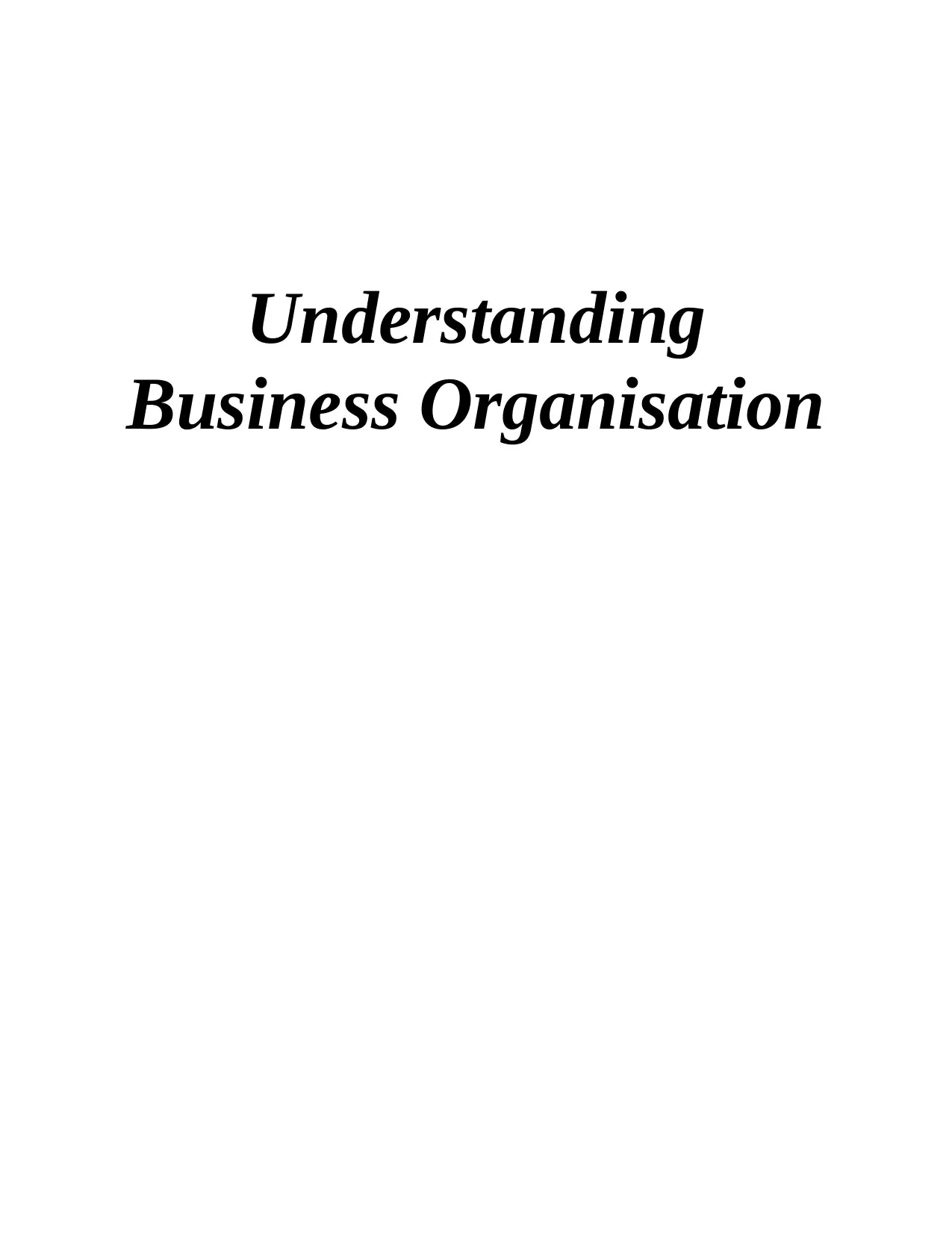
Understanding
Business Organisation
Business Organisation
Paraphrase This Document
Need a fresh take? Get an instant paraphrase of this document with our AI Paraphraser
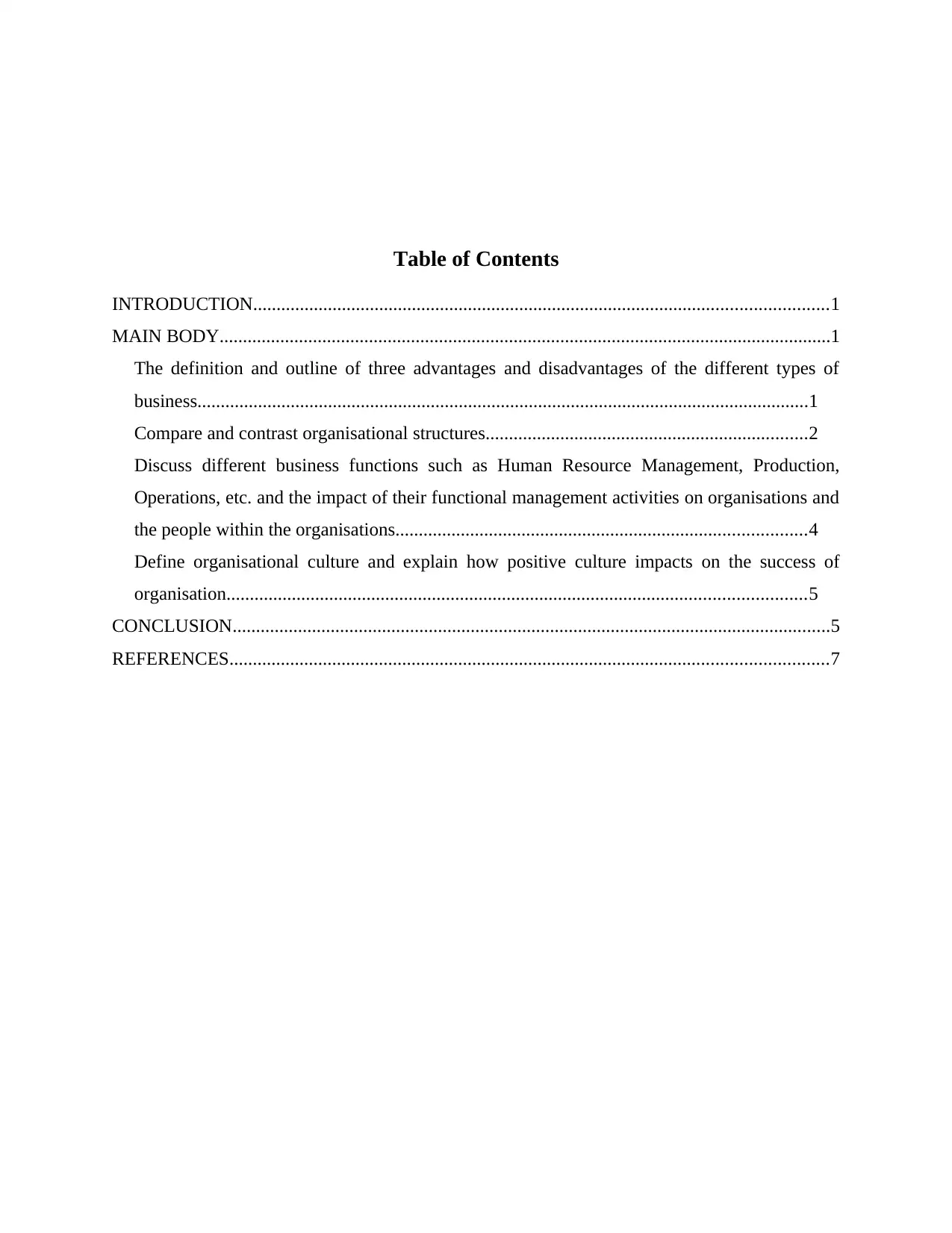
Table of Contents
INTRODUCTION...........................................................................................................................1
MAIN BODY...................................................................................................................................1
The definition and outline of three advantages and disadvantages of the different types of
business...................................................................................................................................1
Compare and contrast organisational structures.....................................................................2
Discuss different business functions such as Human Resource Management, Production,
Operations, etc. and the impact of their functional management activities on organisations and
the people within the organisations........................................................................................4
Define organisational culture and explain how positive culture impacts on the success of
organisation............................................................................................................................5
CONCLUSION................................................................................................................................5
REFERENCES................................................................................................................................7
INTRODUCTION...........................................................................................................................1
MAIN BODY...................................................................................................................................1
The definition and outline of three advantages and disadvantages of the different types of
business...................................................................................................................................1
Compare and contrast organisational structures.....................................................................2
Discuss different business functions such as Human Resource Management, Production,
Operations, etc. and the impact of their functional management activities on organisations and
the people within the organisations........................................................................................4
Define organisational culture and explain how positive culture impacts on the success of
organisation............................................................................................................................5
CONCLUSION................................................................................................................................5
REFERENCES................................................................................................................................7
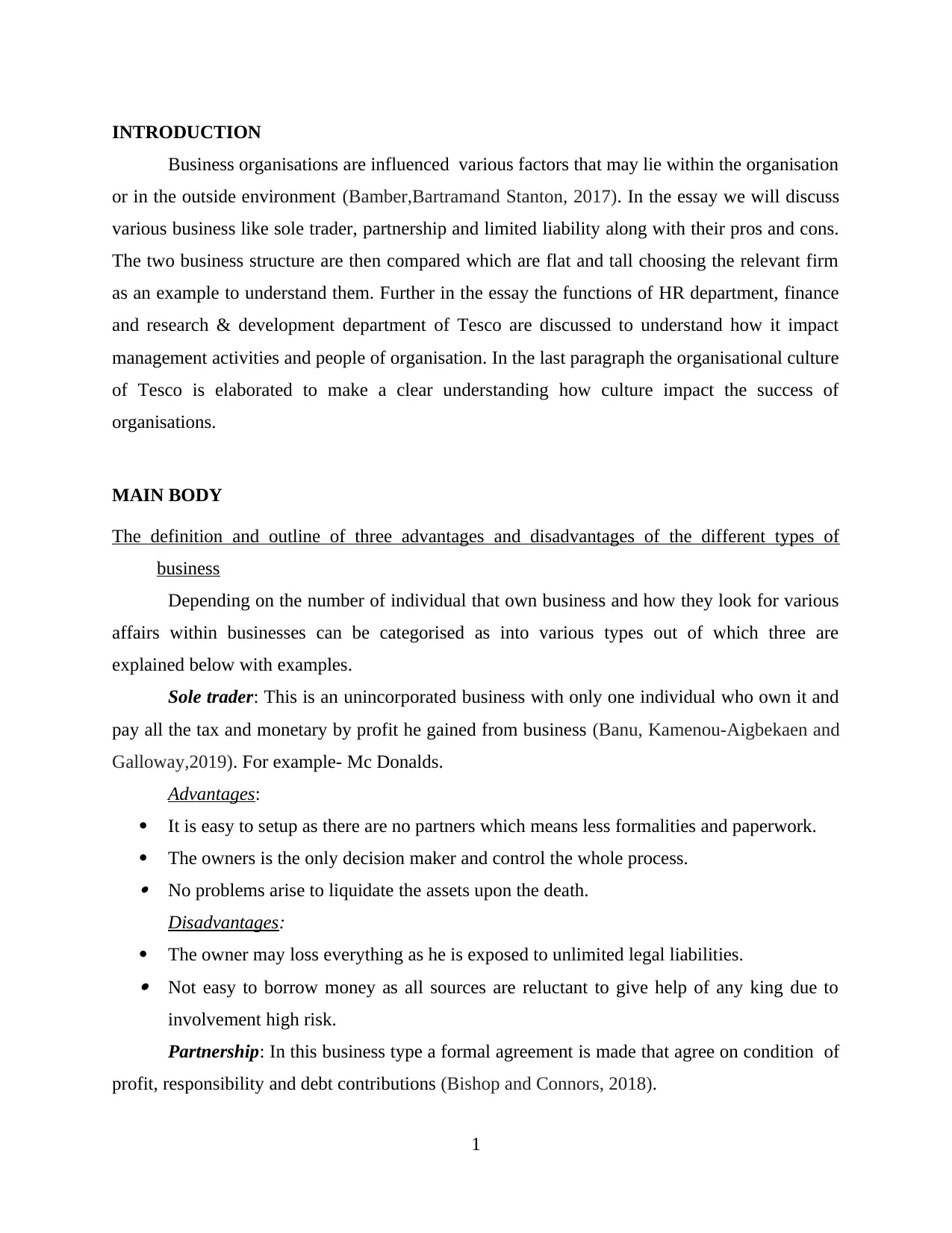
INTRODUCTION
Business organisations are influenced various factors that may lie within the organisation
or in the outside environment (Bamber,Bartramand Stanton, 2017). In the essay we will discuss
various business like sole trader, partnership and limited liability along with their pros and cons.
The two business structure are then compared which are flat and tall choosing the relevant firm
as an example to understand them. Further in the essay the functions of HR department, finance
and research & development department of Tesco are discussed to understand how it impact
management activities and people of organisation. In the last paragraph the organisational culture
of Tesco is elaborated to make a clear understanding how culture impact the success of
organisations.
MAIN BODY
The definition and outline of three advantages and disadvantages of the different types of
business
Depending on the number of individual that own business and how they look for various
affairs within businesses can be categorised as into various types out of which three are
explained below with examples.
Sole trader: This is an unincorporated business with only one individual who own it and
pay all the tax and monetary by profit he gained from business (Banu, Kamenou-Aigbekaen and
Galloway,2019). For example- Mc Donalds.
Advantages:
It is easy to setup as there are no partners which means less formalities and paperwork.
The owners is the only decision maker and control the whole process. No problems arise to liquidate the assets upon the death.
Disadvantages:
The owner may loss everything as he is exposed to unlimited legal liabilities. Not easy to borrow money as all sources are reluctant to give help of any king due to
involvement high risk.
Partnership: In this business type a formal agreement is made that agree on condition of
profit, responsibility and debt contributions (Bishop and Connors, 2018).
1
Business organisations are influenced various factors that may lie within the organisation
or in the outside environment (Bamber,Bartramand Stanton, 2017). In the essay we will discuss
various business like sole trader, partnership and limited liability along with their pros and cons.
The two business structure are then compared which are flat and tall choosing the relevant firm
as an example to understand them. Further in the essay the functions of HR department, finance
and research & development department of Tesco are discussed to understand how it impact
management activities and people of organisation. In the last paragraph the organisational culture
of Tesco is elaborated to make a clear understanding how culture impact the success of
organisations.
MAIN BODY
The definition and outline of three advantages and disadvantages of the different types of
business
Depending on the number of individual that own business and how they look for various
affairs within businesses can be categorised as into various types out of which three are
explained below with examples.
Sole trader: This is an unincorporated business with only one individual who own it and
pay all the tax and monetary by profit he gained from business (Banu, Kamenou-Aigbekaen and
Galloway,2019). For example- Mc Donalds.
Advantages:
It is easy to setup as there are no partners which means less formalities and paperwork.
The owners is the only decision maker and control the whole process. No problems arise to liquidate the assets upon the death.
Disadvantages:
The owner may loss everything as he is exposed to unlimited legal liabilities. Not easy to borrow money as all sources are reluctant to give help of any king due to
involvement high risk.
Partnership: In this business type a formal agreement is made that agree on condition of
profit, responsibility and debt contributions (Bishop and Connors, 2018).
1
⊘ This is a preview!⊘
Do you want full access?
Subscribe today to unlock all pages.

Trusted by 1+ million students worldwide
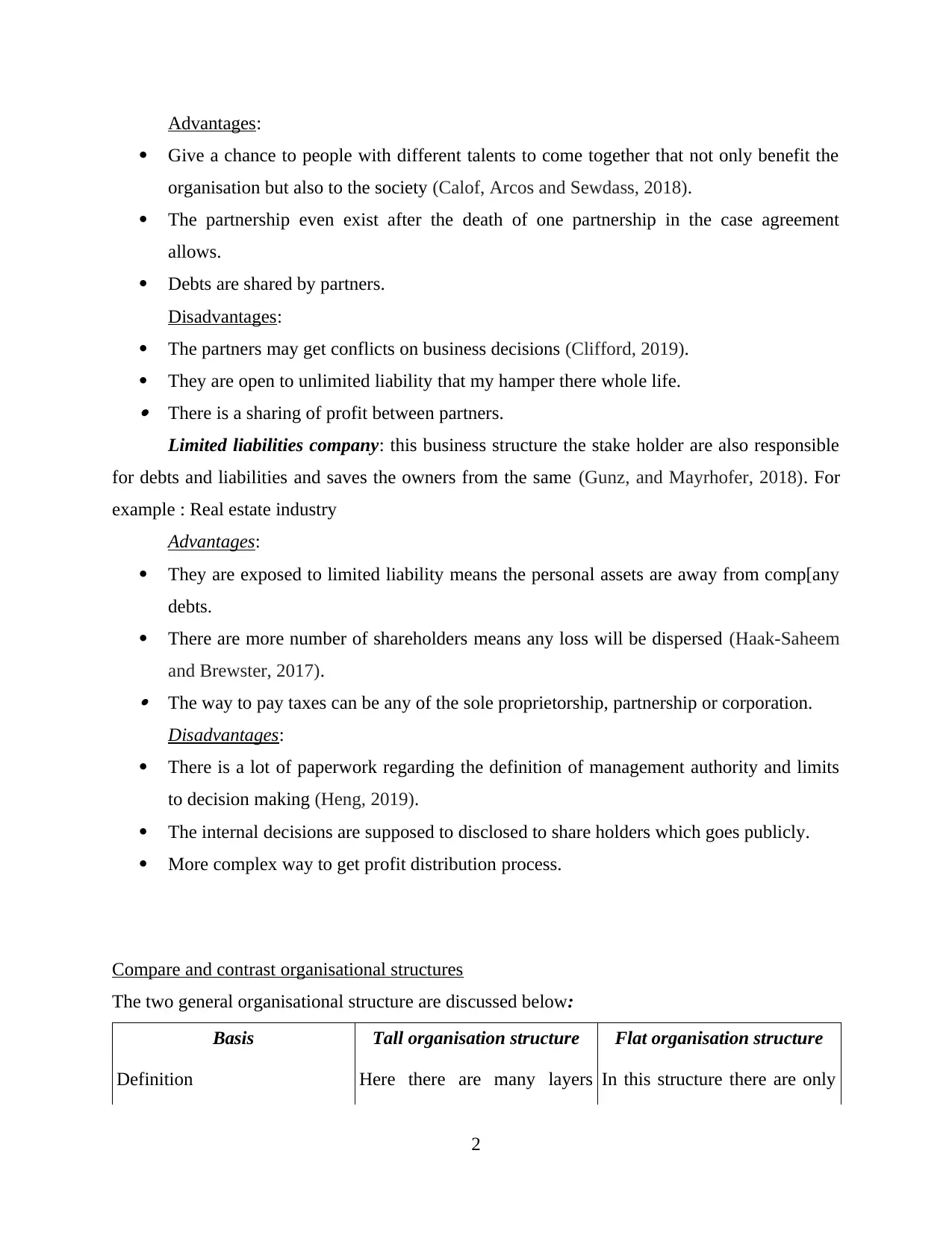
Advantages:
Give a chance to people with different talents to come together that not only benefit the
organisation but also to the society (Calof, Arcos and Sewdass, 2018).
The partnership even exist after the death of one partnership in the case agreement
allows.
Debts are shared by partners.
Disadvantages:
The partners may get conflicts on business decisions (Clifford, 2019).
They are open to unlimited liability that my hamper there whole life. There is a sharing of profit between partners.
Limited liabilities company: this business structure the stake holder are also responsible
for debts and liabilities and saves the owners from the same (Gunz, and Mayrhofer, 2018). For
example : Real estate industry
Advantages:
They are exposed to limited liability means the personal assets are away from comp[any
debts.
There are more number of shareholders means any loss will be dispersed (Haak‐Saheem
and Brewster, 2017). The way to pay taxes can be any of the sole proprietorship, partnership or corporation.
Disadvantages:
There is a lot of paperwork regarding the definition of management authority and limits
to decision making (Heng, 2019).
The internal decisions are supposed to disclosed to share holders which goes publicly.
More complex way to get profit distribution process.
Compare and contrast organisational structures
The two general organisational structure are discussed below:
Basis Tall organisation structure Flat organisation structure
Definition Here there are many layers In this structure there are only
2
Give a chance to people with different talents to come together that not only benefit the
organisation but also to the society (Calof, Arcos and Sewdass, 2018).
The partnership even exist after the death of one partnership in the case agreement
allows.
Debts are shared by partners.
Disadvantages:
The partners may get conflicts on business decisions (Clifford, 2019).
They are open to unlimited liability that my hamper there whole life. There is a sharing of profit between partners.
Limited liabilities company: this business structure the stake holder are also responsible
for debts and liabilities and saves the owners from the same (Gunz, and Mayrhofer, 2018). For
example : Real estate industry
Advantages:
They are exposed to limited liability means the personal assets are away from comp[any
debts.
There are more number of shareholders means any loss will be dispersed (Haak‐Saheem
and Brewster, 2017). The way to pay taxes can be any of the sole proprietorship, partnership or corporation.
Disadvantages:
There is a lot of paperwork regarding the definition of management authority and limits
to decision making (Heng, 2019).
The internal decisions are supposed to disclosed to share holders which goes publicly.
More complex way to get profit distribution process.
Compare and contrast organisational structures
The two general organisational structure are discussed below:
Basis Tall organisation structure Flat organisation structure
Definition Here there are many layers In this structure there are only
2
Paraphrase This Document
Need a fresh take? Get an instant paraphrase of this document with our AI Paraphraser
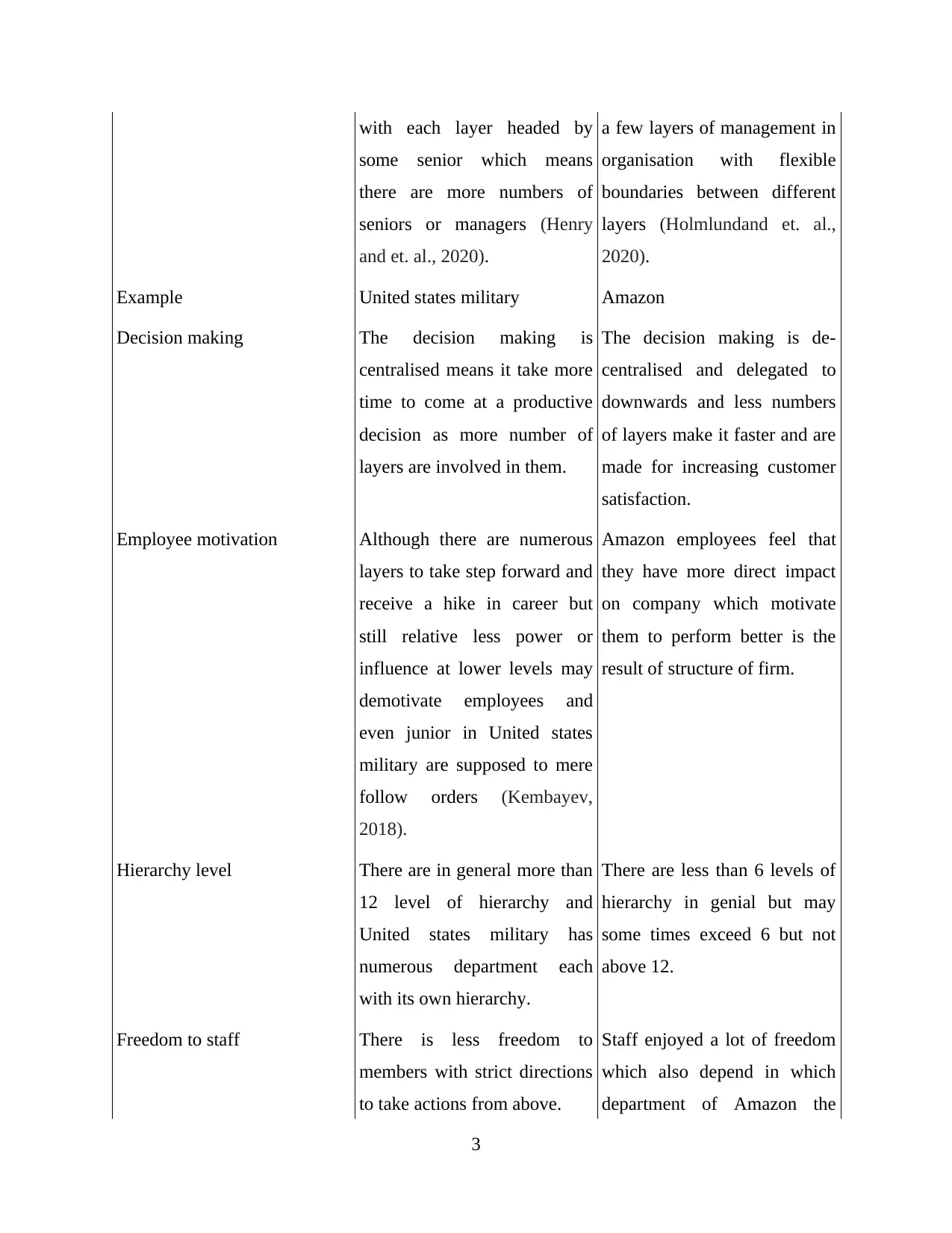
with each layer headed by
some senior which means
there are more numbers of
seniors or managers (Henry
and et. al., 2020).
a few layers of management in
organisation with flexible
boundaries between different
layers (Holmlundand et. al.,
2020).
Example United states military Amazon
Decision making The decision making is
centralised means it take more
time to come at a productive
decision as more number of
layers are involved in them.
The decision making is de-
centralised and delegated to
downwards and less numbers
of layers make it faster and are
made for increasing customer
satisfaction.
Employee motivation Although there are numerous
layers to take step forward and
receive a hike in career but
still relative less power or
influence at lower levels may
demotivate employees and
even junior in United states
military are supposed to mere
follow orders (Kembayev,
2018).
Amazon employees feel that
they have more direct impact
on company which motivate
them to perform better is the
result of structure of firm.
Hierarchy level There are in general more than
12 level of hierarchy and
United states military has
numerous department each
with its own hierarchy.
There are less than 6 levels of
hierarchy in genial but may
some times exceed 6 but not
above 12.
Freedom to staff There is less freedom to
members with strict directions
to take actions from above.
Staff enjoyed a lot of freedom
which also depend in which
department of Amazon the
3
some senior which means
there are more numbers of
seniors or managers (Henry
and et. al., 2020).
a few layers of management in
organisation with flexible
boundaries between different
layers (Holmlundand et. al.,
2020).
Example United states military Amazon
Decision making The decision making is
centralised means it take more
time to come at a productive
decision as more number of
layers are involved in them.
The decision making is de-
centralised and delegated to
downwards and less numbers
of layers make it faster and are
made for increasing customer
satisfaction.
Employee motivation Although there are numerous
layers to take step forward and
receive a hike in career but
still relative less power or
influence at lower levels may
demotivate employees and
even junior in United states
military are supposed to mere
follow orders (Kembayev,
2018).
Amazon employees feel that
they have more direct impact
on company which motivate
them to perform better is the
result of structure of firm.
Hierarchy level There are in general more than
12 level of hierarchy and
United states military has
numerous department each
with its own hierarchy.
There are less than 6 levels of
hierarchy in genial but may
some times exceed 6 but not
above 12.
Freedom to staff There is less freedom to
members with strict directions
to take actions from above.
Staff enjoyed a lot of freedom
which also depend in which
department of Amazon the
3
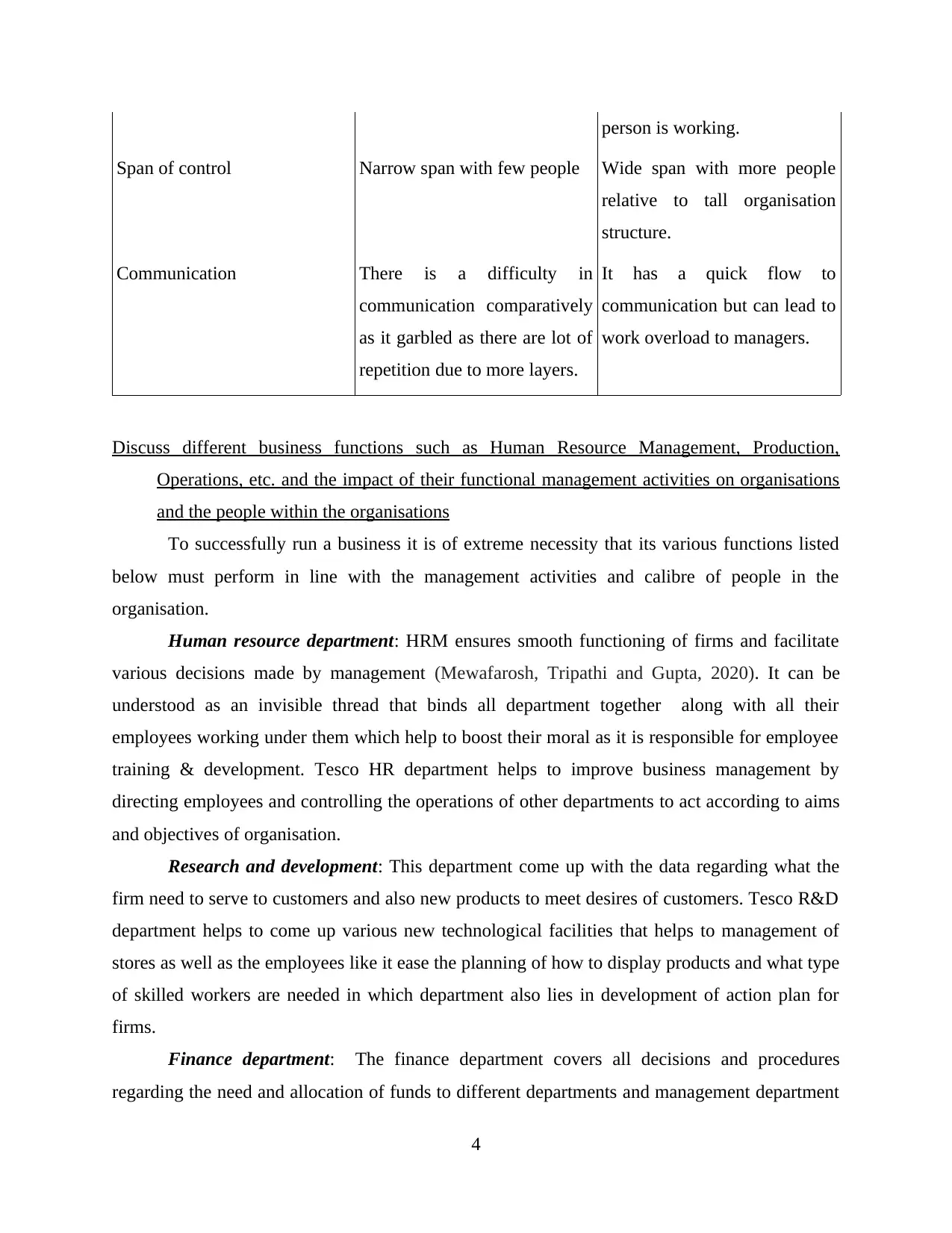
person is working.
Span of control Narrow span with few people Wide span with more people
relative to tall organisation
structure.
Communication There is a difficulty in
communication comparatively
as it garbled as there are lot of
repetition due to more layers.
It has a quick flow to
communication but can lead to
work overload to managers.
Discuss different business functions such as Human Resource Management, Production,
Operations, etc. and the impact of their functional management activities on organisations
and the people within the organisations
To successfully run a business it is of extreme necessity that its various functions listed
below must perform in line with the management activities and calibre of people in the
organisation.
Human resource department: HRM ensures smooth functioning of firms and facilitate
various decisions made by management (Mewafarosh, Tripathi and Gupta, 2020). It can be
understood as an invisible thread that binds all department together along with all their
employees working under them which help to boost their moral as it is responsible for employee
training & development. Tesco HR department helps to improve business management by
directing employees and controlling the operations of other departments to act according to aims
and objectives of organisation.
Research and development: This department come up with the data regarding what the
firm need to serve to customers and also new products to meet desires of customers. Tesco R&D
department helps to come up various new technological facilities that helps to management of
stores as well as the employees like it ease the planning of how to display products and what type
of skilled workers are needed in which department also lies in development of action plan for
firms.
Finance department: The finance department covers all decisions and procedures
regarding the need and allocation of funds to different departments and management department
4
Span of control Narrow span with few people Wide span with more people
relative to tall organisation
structure.
Communication There is a difficulty in
communication comparatively
as it garbled as there are lot of
repetition due to more layers.
It has a quick flow to
communication but can lead to
work overload to managers.
Discuss different business functions such as Human Resource Management, Production,
Operations, etc. and the impact of their functional management activities on organisations
and the people within the organisations
To successfully run a business it is of extreme necessity that its various functions listed
below must perform in line with the management activities and calibre of people in the
organisation.
Human resource department: HRM ensures smooth functioning of firms and facilitate
various decisions made by management (Mewafarosh, Tripathi and Gupta, 2020). It can be
understood as an invisible thread that binds all department together along with all their
employees working under them which help to boost their moral as it is responsible for employee
training & development. Tesco HR department helps to improve business management by
directing employees and controlling the operations of other departments to act according to aims
and objectives of organisation.
Research and development: This department come up with the data regarding what the
firm need to serve to customers and also new products to meet desires of customers. Tesco R&D
department helps to come up various new technological facilities that helps to management of
stores as well as the employees like it ease the planning of how to display products and what type
of skilled workers are needed in which department also lies in development of action plan for
firms.
Finance department: The finance department covers all decisions and procedures
regarding the need and allocation of funds to different departments and management department
4
⊘ This is a preview!⊘
Do you want full access?
Subscribe today to unlock all pages.

Trusted by 1+ million students worldwide
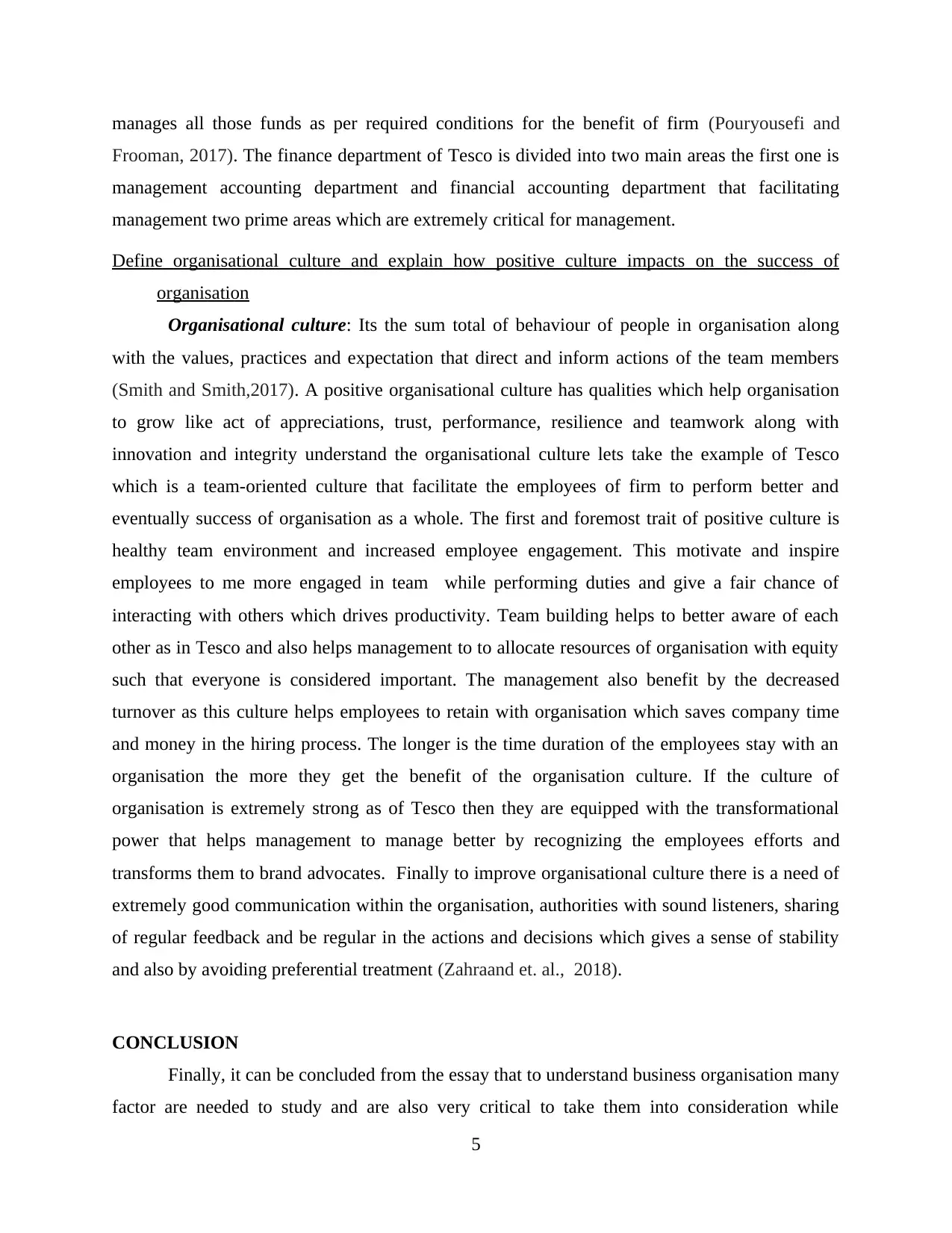
manages all those funds as per required conditions for the benefit of firm (Pouryousefi and
Frooman, 2017). The finance department of Tesco is divided into two main areas the first one is
management accounting department and financial accounting department that facilitating
management two prime areas which are extremely critical for management.
Define organisational culture and explain how positive culture impacts on the success of
organisation
Organisational culture: Its the sum total of behaviour of people in organisation along
with the values, practices and expectation that direct and inform actions of the team members
(Smith and Smith,2017). A positive organisational culture has qualities which help organisation
to grow like act of appreciations, trust, performance, resilience and teamwork along with
innovation and integrity understand the organisational culture lets take the example of Tesco
which is a team-oriented culture that facilitate the employees of firm to perform better and
eventually success of organisation as a whole. The first and foremost trait of positive culture is
healthy team environment and increased employee engagement. This motivate and inspire
employees to me more engaged in team while performing duties and give a fair chance of
interacting with others which drives productivity. Team building helps to better aware of each
other as in Tesco and also helps management to to allocate resources of organisation with equity
such that everyone is considered important. The management also benefit by the decreased
turnover as this culture helps employees to retain with organisation which saves company time
and money in the hiring process. The longer is the time duration of the employees stay with an
organisation the more they get the benefit of the organisation culture. If the culture of
organisation is extremely strong as of Tesco then they are equipped with the transformational
power that helps management to manage better by recognizing the employees efforts and
transforms them to brand advocates. Finally to improve organisational culture there is a need of
extremely good communication within the organisation, authorities with sound listeners, sharing
of regular feedback and be regular in the actions and decisions which gives a sense of stability
and also by avoiding preferential treatment (Zahraand et. al., 2018).
CONCLUSION
Finally, it can be concluded from the essay that to understand business organisation many
factor are needed to study and are also very critical to take them into consideration while
5
Frooman, 2017). The finance department of Tesco is divided into two main areas the first one is
management accounting department and financial accounting department that facilitating
management two prime areas which are extremely critical for management.
Define organisational culture and explain how positive culture impacts on the success of
organisation
Organisational culture: Its the sum total of behaviour of people in organisation along
with the values, practices and expectation that direct and inform actions of the team members
(Smith and Smith,2017). A positive organisational culture has qualities which help organisation
to grow like act of appreciations, trust, performance, resilience and teamwork along with
innovation and integrity understand the organisational culture lets take the example of Tesco
which is a team-oriented culture that facilitate the employees of firm to perform better and
eventually success of organisation as a whole. The first and foremost trait of positive culture is
healthy team environment and increased employee engagement. This motivate and inspire
employees to me more engaged in team while performing duties and give a fair chance of
interacting with others which drives productivity. Team building helps to better aware of each
other as in Tesco and also helps management to to allocate resources of organisation with equity
such that everyone is considered important. The management also benefit by the decreased
turnover as this culture helps employees to retain with organisation which saves company time
and money in the hiring process. The longer is the time duration of the employees stay with an
organisation the more they get the benefit of the organisation culture. If the culture of
organisation is extremely strong as of Tesco then they are equipped with the transformational
power that helps management to manage better by recognizing the employees efforts and
transforms them to brand advocates. Finally to improve organisational culture there is a need of
extremely good communication within the organisation, authorities with sound listeners, sharing
of regular feedback and be regular in the actions and decisions which gives a sense of stability
and also by avoiding preferential treatment (Zahraand et. al., 2018).
CONCLUSION
Finally, it can be concluded from the essay that to understand business organisation many
factor are needed to study and are also very critical to take them into consideration while
5
Paraphrase This Document
Need a fresh take? Get an instant paraphrase of this document with our AI Paraphraser
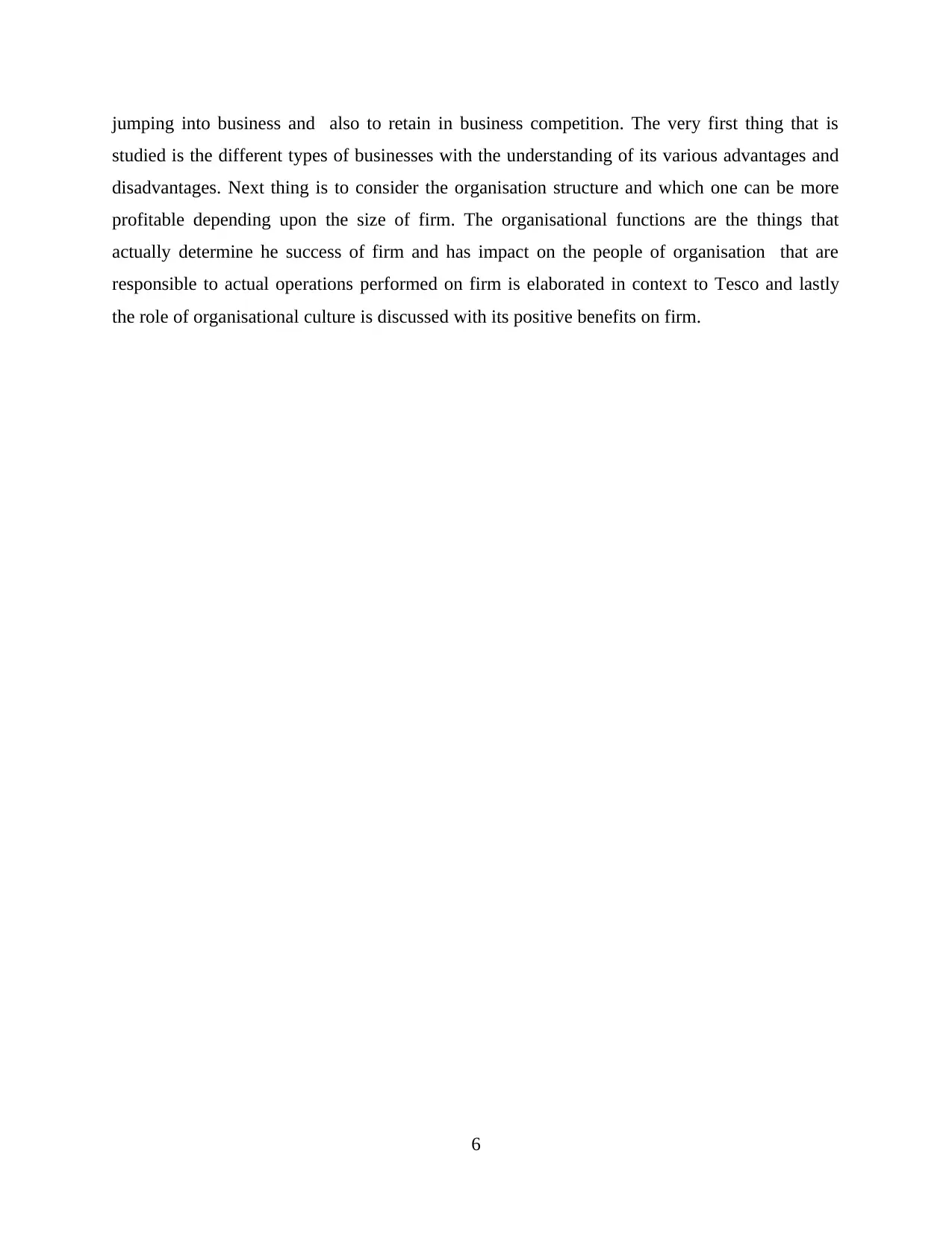
jumping into business and also to retain in business competition. The very first thing that is
studied is the different types of businesses with the understanding of its various advantages and
disadvantages. Next thing is to consider the organisation structure and which one can be more
profitable depending upon the size of firm. The organisational functions are the things that
actually determine he success of firm and has impact on the people of organisation that are
responsible to actual operations performed on firm is elaborated in context to Tesco and lastly
the role of organisational culture is discussed with its positive benefits on firm.
6
studied is the different types of businesses with the understanding of its various advantages and
disadvantages. Next thing is to consider the organisation structure and which one can be more
profitable depending upon the size of firm. The organisational functions are the things that
actually determine he success of firm and has impact on the people of organisation that are
responsible to actual operations performed on firm is elaborated in context to Tesco and lastly
the role of organisational culture is discussed with its positive benefits on firm.
6

REFERENCES
Books and Journals
Bamber, G.J., Bartram, T. and Stanton, P., 2017. HRM and workplace innovations: formulating
research questions. Personnel Review.
Banu, S., Kamenou-Aigbekaen, N. and Galloway, L., 2019. A relational approach to exploring
inequalities within the human resource management model in the Middle
East. International Journal of Work Organisation and Emotion. 10(3). pp.216-231.
Bishop, P. and Connors, C., 2018. Management, organisation, and ethics in the public sector.
Routledge.
Calof, J., Arcos, R. and Sewdass, N., 2018. Competitive intelligence practices of European
firms. Technology Analysis & Strategic Management. 30(6). pp.658-671.
Clifford, R., 2019. A Qualitative Investigation focusing on Cultural Diversity within a Public
Sector Organisation in Dublin (Doctoral dissertation, Dublin, National College of
Ireland).
Gunz, H. and Mayrhofer, W., 2018. Career development: Insights from organisation theory.
In Contemporary Theories of Career Development (pp. 209-223). Routledge.
Haak‐Saheem, W. and Brewster, C., 2017. ‘Hidden’expatriates: international mobility in the
United Arab Emirates as a challenge to current understanding of expatriation. Human
Resource Management Journal. 27(3). pp.423-439.
Heng, T.T., 2019. Understanding the heterogeneity of international students’ experiences: A case
study of Chinese international students in US universities. Journal of Studies in
International Education. 23(5). pp.607-623.
Henry, M. and et. al., 2020. A typology of circular start-ups: An Analysis of 128 circular
business models. Journal of Cleaner Production, 245, p.118528.
Holmlund, M. and et. al., 2020. Customer experience management in the age of big data
analytics: A strategic framework. Journal of Business Research. 116. pp.356-365.
Kembayev, Z., 2018. Implementing the silk road Economic Belt: from the Shanghai cooperation
organisation to the silk road union?. Asia Europe Journal. 16(1).pp.37-50.
Mewafarosh, R., Tripathi, V. and Gupta, S., 2020. A conceptual study: organisation culture as an
antecedent to employee engagement. International Journal of Environment, Workplace
and Employment. 6(1-2). pp.3-19.
Pouryousefi, S. and Frooman, J., 2017. The problem of unilateralism in agency theory: towards a
bilateral formulation. Business Ethics Quarterly.27(2). pp.163-182.
Smith, A.P. and Smith, H., 2017. A short questionnaire to measure wellbeing at work (Short-
SWELL) and to examine the interaction between the employee and organisation.
Zahra, A. and et. al., 2018. Economic or Organisation Perspective?: Triangulation of Workplace
Spirituality, Organisational Learning Capacity (OLC) and Organisational Trust. Global
Economics Review.3(2). pp.20-33.
7
Books and Journals
Bamber, G.J., Bartram, T. and Stanton, P., 2017. HRM and workplace innovations: formulating
research questions. Personnel Review.
Banu, S., Kamenou-Aigbekaen, N. and Galloway, L., 2019. A relational approach to exploring
inequalities within the human resource management model in the Middle
East. International Journal of Work Organisation and Emotion. 10(3). pp.216-231.
Bishop, P. and Connors, C., 2018. Management, organisation, and ethics in the public sector.
Routledge.
Calof, J., Arcos, R. and Sewdass, N., 2018. Competitive intelligence practices of European
firms. Technology Analysis & Strategic Management. 30(6). pp.658-671.
Clifford, R., 2019. A Qualitative Investigation focusing on Cultural Diversity within a Public
Sector Organisation in Dublin (Doctoral dissertation, Dublin, National College of
Ireland).
Gunz, H. and Mayrhofer, W., 2018. Career development: Insights from organisation theory.
In Contemporary Theories of Career Development (pp. 209-223). Routledge.
Haak‐Saheem, W. and Brewster, C., 2017. ‘Hidden’expatriates: international mobility in the
United Arab Emirates as a challenge to current understanding of expatriation. Human
Resource Management Journal. 27(3). pp.423-439.
Heng, T.T., 2019. Understanding the heterogeneity of international students’ experiences: A case
study of Chinese international students in US universities. Journal of Studies in
International Education. 23(5). pp.607-623.
Henry, M. and et. al., 2020. A typology of circular start-ups: An Analysis of 128 circular
business models. Journal of Cleaner Production, 245, p.118528.
Holmlund, M. and et. al., 2020. Customer experience management in the age of big data
analytics: A strategic framework. Journal of Business Research. 116. pp.356-365.
Kembayev, Z., 2018. Implementing the silk road Economic Belt: from the Shanghai cooperation
organisation to the silk road union?. Asia Europe Journal. 16(1).pp.37-50.
Mewafarosh, R., Tripathi, V. and Gupta, S., 2020. A conceptual study: organisation culture as an
antecedent to employee engagement. International Journal of Environment, Workplace
and Employment. 6(1-2). pp.3-19.
Pouryousefi, S. and Frooman, J., 2017. The problem of unilateralism in agency theory: towards a
bilateral formulation. Business Ethics Quarterly.27(2). pp.163-182.
Smith, A.P. and Smith, H., 2017. A short questionnaire to measure wellbeing at work (Short-
SWELL) and to examine the interaction between the employee and organisation.
Zahra, A. and et. al., 2018. Economic or Organisation Perspective?: Triangulation of Workplace
Spirituality, Organisational Learning Capacity (OLC) and Organisational Trust. Global
Economics Review.3(2). pp.20-33.
7
⊘ This is a preview!⊘
Do you want full access?
Subscribe today to unlock all pages.

Trusted by 1+ million students worldwide
1 out of 9
Related Documents
Your All-in-One AI-Powered Toolkit for Academic Success.
+13062052269
info@desklib.com
Available 24*7 on WhatsApp / Email
![[object Object]](/_next/static/media/star-bottom.7253800d.svg)
Unlock your academic potential
Copyright © 2020–2025 A2Z Services. All Rights Reserved. Developed and managed by ZUCOL.



